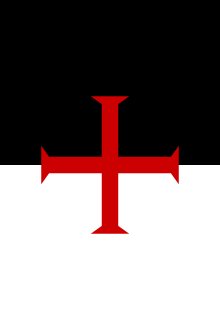- Military order
-
A military order is a Christian society of knights that was founded for crusading, i.e. propagating and/or defending the faith (originally Catholic, after the reformation sometimes Protestant), either in the Holy Land or against Islam (Reconquista) or pagans (mainly Baltic region) in Europe. Many orders became secularized later.
Contents
History
Catholic military orders appeared following the First Crusade in response to the Islamic conquest of the former Byzantine Christian Holy Land. The foundation of the Templars in 1118 provided the first in a series of tightly organized military forces which protected the Christian lands in Outremer, as well as fighting invading Muslims in the Iberian Peninsula as well as Muslim invaders and pagan tribes in Eastern Europe.
The first secularized order was the Order of Saint George founded in 1326 by the King Charles I of Hungary, on which he made all the nobles of the Kingdom to swear loyalty to his persona. The next secular order which is known to appear was the Order of the "Knights of the Band", founded by the King Alfonso XI of Castile in 1332. Both orders existed only for about a century.[1]
Purpose and function
The principal feature of the military order is the combination of military and religious ways of life. Some of them, like the Knights of St John and the Knights of Saint Thomas, also cared for the sick and poor. However, they were not purely male institutions, as nuns could attach themselves as convents of the orders. One significant feature of the military orders is that clerical brothers could be, and indeed often were, subordinate to non-ordained brethren.
In 1818 Joseph von Hammer compared the Catholic military orders, in particular the Templars, with certain Islamic models such as the Shiite sect of Assassins. In 1820 José Antonio Conde has suggested they were modeled on the ribat, a fortified religious institution which brought together a religious way of life with fighting the enemies of Islam. However popular such views may have become, others have criticized this view suggesting there were no such ribats around Palestine until after the military orders had been founded. Yet the innovation of the role and function of the military orders has sometimes been obscured by the concentration on their military exploits in Syria, Palestine, Prussia, and Livonia. In fact they had extensive holdings and staff throughout Western Europe. The majority were laymen. They provided a conduit for cultural and technical innovation, for example the introduction of fulling into England by the Knights of St John, or the banking facilities of the Templars.
Because of the necessity to have a standing army, the military orders were created, being adopted as the fourth monastic vow.
List of military orders
This list is intended to be comprehensive. The orders are listed chronologically according to their dates of foundation (in parentheses), which are sometimes approximate, and may in significance vary from case to case, the foundation of an order, its ecclesiastical approval, and its militarisation occurring at times on different dates.
- Knights Hospitaller (1080)
- Order of Saint James of Altopascio (ca. 1075)
- Sovereign Military Order of Malta (1099)
- Equestrian Order of the Holy Sepulchre of Jerusalem (1113)
- Knights Templar (ca. 1118)
- Order of Saint Lazarus (ca. 1123)
- Order of Aviz (1128)
- Order of Saint Michael of the Wing (1147)
- Order of Calatrava (1158)
- Order of Aubrac (1162)
- Order of Santiago (1170)
- Order of Alcántara (1177)
- Order of Mountjoy (c.1180)
- Teutonic Knights (1190)
- Hospitallers of Saint Thomas of Canterbury at Acre (1191)
- Order of Monfragüe (1196)
- Order of Sant Jordi d'Alfama (1201)
- Livonian Brothers of the Sword (1202)
- Order of Dobrzyń (1216)
- Order of the Blessed Virgin Mary of Mercy (1218)
- Knights of the Cross with the Red Star (before 1219)
- Militia of the Faith of Jesus Christ (1221)
- Order of the Faith and Peace (1231)
- Militia of Jesus Christ (1233)
- Order of the Blessed Virgin Mary (1261)
- Order of Santa María de España (1275)
- Order of Montesa (1317)
- Order of the Knights of Our Lord Jesus Christ (1318)
- Order of the Dragon (1408)
- Order of Saint Maurice (1434)
- Order of Our Lady of Bethlehem (1459)
- Order of Saint George of Carinthia (1469)
- Order of Saint George of Parma (before 1522)
- Order of Saint Stephen (1561)
Other uses
It is possible for a non-crusading order to be founded explicitly as a military order. This is the case of the Orden Militar de la Constancia ('the Military Order of Loyalty'), founded on August 18, 1946, by the authorities in the Spanish protectorate within Morocco. Awarded to both Spanish and Moroccan military officers and men, the single-class order was abolished in 1956.
It was in the military orders, where the perfect fusion of the religious and the military spirit was realized, that chivalry reached its apogee. It was at this apogee that the secular brotherhood was created.
The Dutch Military Order of William and the Austrian Military Order of Maria Theresa are not military orders although they use that name. They are orders of merit, not societies of knights or warrior-monks like the original military orders.
Some self-styled orders claim to be military orders.
References
- ^ The New Cambridge Medieval History, vol. 6: c. 1300 - c. 1415, Michael Jones (ed.) (Cambridge, 1998), p. 209.
- Forey, Alan John. The Military Orders: From the Twelfth to the Early Fourteenth Centuries. Basingstoke: Macmillan Education, 1992.
- "Military Orders" in Catholic Encyclopedia
Categories:- Orders of knighthood
- Military orders
- Christian orders
- Christianity and violence
Wikimedia Foundation. 2010.

